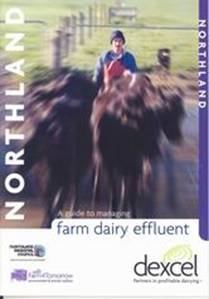Compliance monitoring in detail – Farm Dairy Effluent
Within this section…
Summary 2007-08
Overview
· Approximately 950 dairy farms in Northland in 2007-08.
· Producing 11 thousand cubic metres of farm dairy effluent (FDE) per day.
· 684 consented discharges of FDE in 2007-08.
· 258 non-consented farms discharging FDE to land under the permitted activity rule in the Regional Water and Soil Plan.
· All consented and non-consented farms monitored annually by NRC.
Performance Targets
To monitor and enforce compliance with farm dairy effluent (FDE) discharge standards by:
· Inspecting all FDE treatment and discharge systems annually, record inspection details and report these to the farmers responsible - ACHIEVED
· Testing effluent and receiving water quality annually, for systems with resource consents to discharge to water - ACHIEVED
· Follow up on all non-complying systems, systems that have had poor grades, or those requiring maintenance or upgrading, when needed - ACHIEVED
Summary of Results 2007-08
· 48% of FDE consented discharges fully compliant.
· 19% of FDE consented discharges significantly non-compliant.
· 56% of non-consented farms met the "permitted activity" rule.
· 44% of non-consented farms graded as significantly non-compliant with the permitted activity rule or requiring resource consent or undertaking a prohibited activity.
· 2 successful prosecutions for unlawful discharge of FDE in 2007-08.
Introduction
There are approximately 950 dairy farms in Northland. Collectively they produce over 11 thousand cubic metres of farm dairy effluent (FDE) per day. This effluent can be applied to land or it must be adequately treated before disposal to water.
The rules that apply to FDE are set out in the Regional Water and Soil Plan (RWSP) for Northland. The disposal of untreated or treated animal effluent and farm wastewater to land is a "permitted activity" subject to conditions ensuring it does not have an adverse effect on the environment or impact on neighbouring properties. All farms that meet the requirements of the permitted activity rule are monitored annually by NRC as non-consented farms.
The disposal of treated animal effluent to water, provided that the water is not a listed Dune Lake, watercourse flowing into a listed Dune Lake, or river or lake deemed to have outstanding values, is a "discretionary activity". This means that resource consent is required to authorise the discharge. The consent holder is required to abide by the conditions contained in their specific consent. Qualified contractors annually monitor consented farms for compliance.
The discharge of untreated animal effluent to water is prohibited. The RMA also prohibits the discharge of untreated effluent into or onto land in circumstances that may result in that effluent entering water, unless specifically authorised by resource consent or a rule in a plan.
Monitoring targets are set and followed to gauge compliance with the rules (see Performance Targets). In 2007-08, 48% of FDE consented discharges were fully compliant with their consent conditions and 56% of non-consented farms met the ‘permitted activity' rule.
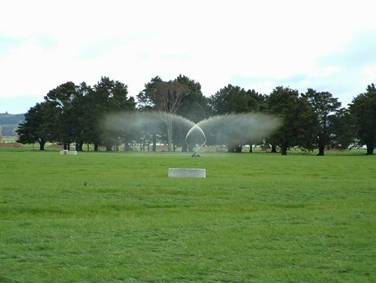
Photo: Land application of farm dairy effluent via an irrigator
Resource Consent Monitoring
Annual inspections are done by contractors or council staff to check if resource consent conditions are being complied with. Water samples are taken to measure if the discharge is having an adverse affect on the receiving water quality. Generally, three samples are taken; an upstream sample, a point of discharge (POD) sample, and a downstream sample. The water quality at the downstream site (also called the consent compliance site) must meet the water quality conditions as specified in the consent. An upstream sample is taken to rule out any other factors that may be affecting the quality of the water at the time of sampling.
Typical Test Results
The water is tested for temperature, dissolved oxygen concentration, faecal coliforms, pH and ammonium. Faecal coliforms are used as an indicator for all pathogenic organisms. The table below shows typical test results for a compliant, consented farm. All test results at the consent compliance site meet their consent conditions.
|
| Analysis |
Sampling Site | ||
| 20m Upstream of POD | Point of Discharge (POD) | 20m Downstream of POD | |
| Dissolved Oxygen (g/m3) |
8.7 | 1.8 | 7.9 |
| Faecal Coliforms (No/100ml) |
92 | 1100 | 400 |
| Ammoniacal Nitrogen (g/m3) |
0.01 | 30.1 | 0.04 |
| pH |
7.9 | 7.6 | 7.7 |
| Temperature (0C) |
13.9 | 18.6 | 14.4 |
The photo below highlights the difference in samples collected from a non-compliant FDE treatment system with the upstream sample to the far left (numbered one), the point of discharge sample in the centre (numbered two) and the downstream sample (numbered three).
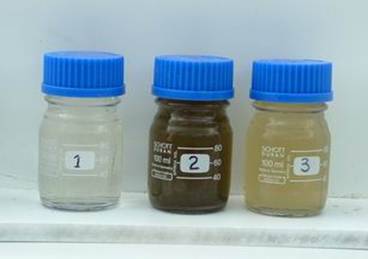
Monitoring Results
In 2007-08, there were 684 consented discharges of FDE, compared to 711 in 2006-07. Of the consented discharges in 2007-08, 328 met all consent conditions and 226 had minor non-compliance. Farms reported as having minor non-compliance had water quality results with only minor transgressions from the standard, or results that complied but maintenance work was required on the FDE system, e.g., an effluent pond needed de-sludging or stormwater controls required attention.
In 2007-08, a further 130 farms had significant non compliance with the conditions of their FDE resource consent, which means their water quality results were considerably outside of their consent conditions. Follow up visits by NRC staff were carried out on all farms with significantly non-compliant FDE treatment/disposal systems and formal enforcement action, including abatement and infringement notices, was taken where required.
The table below summarises the compliance results for FDE consented discharges for 2007-08 compared to the FDE consented discharges in 2006-07. As can be seen from this table, consent compliance has remained static for the last two years.
Full Consent Compliance |
Minor Non-compliance |
Significant Non-compliance | |||
| 2006-07 | 2007-08 | 2006-07 | 2007-08 | 2006-07 | 2007-08 |
48% |
48% |
33% |
33% |
19% |
19% |
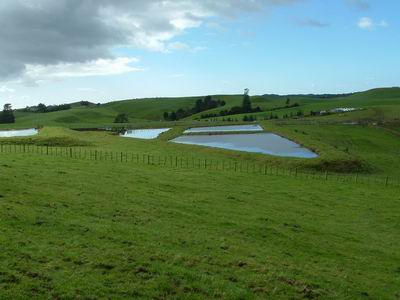
Photo: A series of well-constructed farm dairy effluent treatment ponds
Non-consented Monitoring
Visual inspections are also carried out annually on farms that do not have resource consent. The treatment/disposal system at each farm is graded on a scale of 1P to 4P, with a "1P" being a good system with no work required (fully compliant), and "4P" indicating an unsatisfactory system which needs urgent or major work (significant non-compliance). The system can also be graded as "C", which means resource consent is required, or "X" which indicates a prohibited activity is occurring. Water Quality samples are taken where there is a discharge to water.
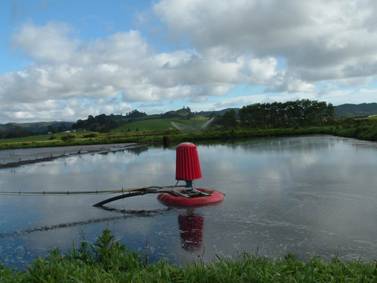
Photo: A fully compliant FDE treatment and disposal system
Monitoring Results
In 2007-08, 258 farms were discharging FDE to land under the "permitted activity" rule, compared to 274 in 2006-07. In 2007-08, 145 farms met the criteria for the ‘permitted activity' rule (includes grades 1P to 3P), while 23 had a significantly non-compliant system (grade 4P). 50 farms discharged treated effluent to water and so required resource consent (grade C) or a system upgrade, and a further 40 farms discharged untreated effluent to water, which is a prohibited activity (grade X). Grades "C" and "X" are included in the significantly non-complaint category for the purposes of analysing these results.
Similarly to the consented discharges, NRC staff carried out follow up visits on all farms with significantly non-compliant (grades 4P, C or X) treatment/disposal systems and formal enforcement action was taken where required.
The table below shows the percentage of non-consented farms who complied with the conditions of the permitted activity rule in 2007-08, compared to those monitored in 2006-07. As can be seen from this table, there has been a slight increase in the number of farms that are significantly non-compliant with the conditions of the permitted activity rule in 2007-08.
| Compliance | 2006-07 | 2007-08 |
| Fully compliant | 48% | 34% |
| Minor non-compliance | 18% | 22% |
| Significant non-compliance | 34% | 44% |
Enforcement Action
The three main mechanisms used by NRC to enforce RMA regulations, rules in the Regional Plans or the conditions of resource consent are: follow up visits with farmers, infringement notices or abatement notices. In serious cases, it may also be necessary to prosecute individuals or companies who have broken the law.
During 2007-08, 92 infringement notices and 113 abatement notices were issued for non complying FDE systems (this figure includes both consented and non-consented farms).
In addition, NRC successfully prosecuted 2 farms in 2007-08 for illegal discharges of FDE. The fines given by the Court were $20,000 and $23,000.
The table below gives the figures for enforcement action taken in 2007-08, compared to action taken in 2006-07. As can be seen, there has been an increase in enforcement action taken, which corresponds with an increase in significant non-compliance on non-consented farms.
| 2006-07 | 2007-08 | |
| Infringement Notices | 41 | 92 |
| Abatement Notices | 68 | 113 |
| Prosecutions | 1 | 2 |
More Information
In Northland, heavy soils, hilly terrain and prolonged wet weather often makes effective land disposal difficult. "Environmentally friendly" disposal systems are generally those with high volume storage or treatment ponds, combined with land application when soil conditions are suitable. Several brochures are available on the NRC website - http://www.nrc.govt.nz/Resource-Library-Summary/Publications/Waste/ - which provide further information for farmers on effective treatment and disposal systems. These include:
· A Guide to Managing Farm Dairy Effluent
· Farm Dairy Effluent – Managing Treatment Ponds
· Farm Dairy Effluent – Managing Stormwater
· Dairying and Clean Stream Accord
· Dead Stock Disposal
· Help protect our coast – keep stock out of the tide
